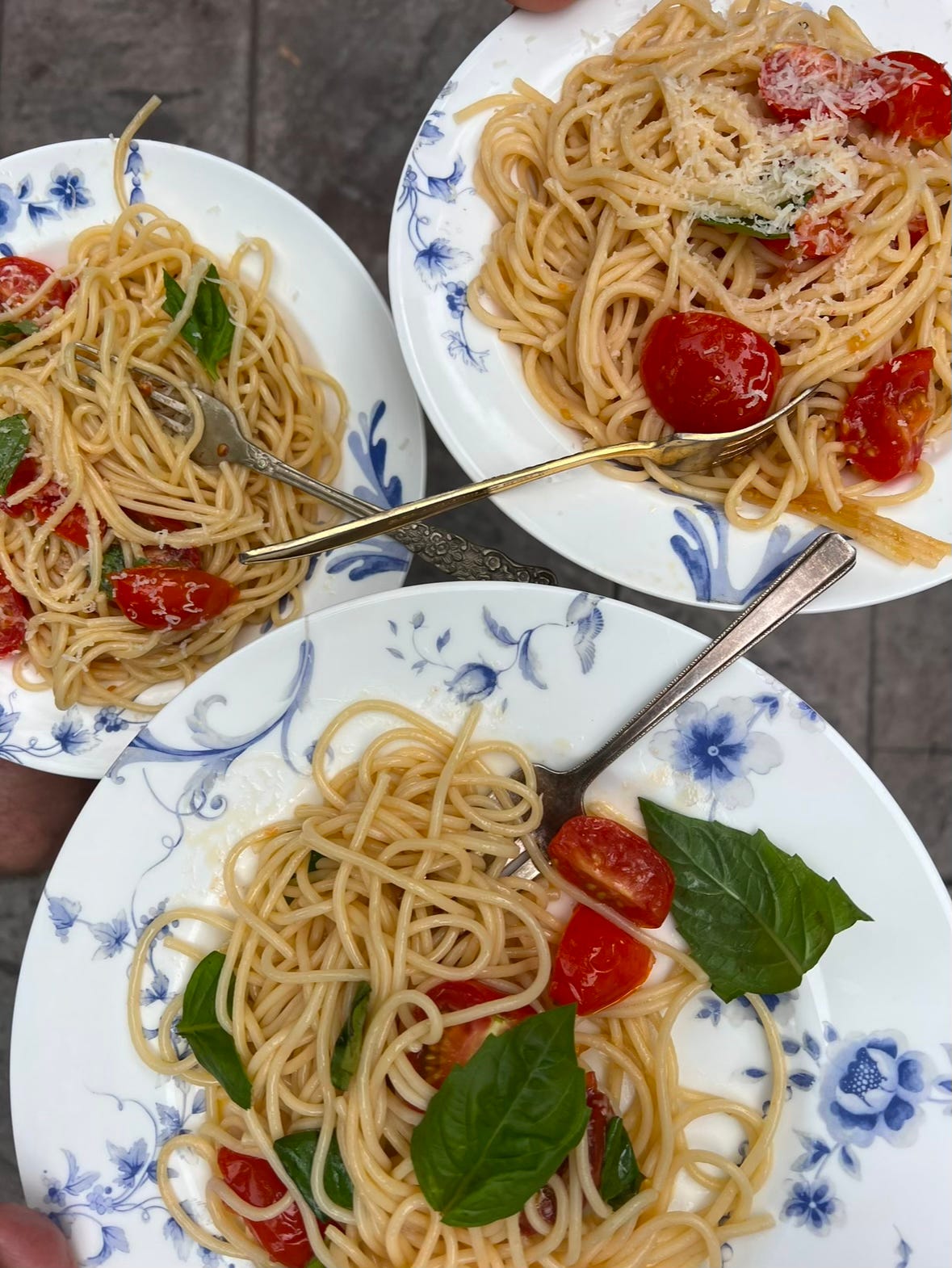Pasta and Permanence: A Recipe That Feels Like Home
On moving, memories, and the simple joys of a timeless dish.
We moved to our new home near Casa Loma last Fall, just as the leaves started to rustle on the branches a bit. Summer tomatoes were in full bloom at Wychwood Farmer’s Market. They sat in crates like scattered jewels, each one imperfectly perfect. These tomatoes felt like the memory of Toronto summer afternoons spent in my friend’s backyard; slices of tomatoes on a platter, a drizzle of olive oil, a bit of sea salt. Slices of freshly sliced sourdough. A glass of chilled bubbly from a tiny vineyard in the Jura, (my favourite).
The first few days in our new house were a blur of boxes, but there was something about the faint chemical smell of our newly painted white floors which told me this house was mine. I had been to the market earlier that morning, as usual, with my friend Nom, and filled my bag with garlic, misshapen heirloom tomatoes glowing in hues of crimson and saffron, and a heady bunch of emerald-green basil.
I looked for my Lagostina pot, the one I had brought back from Rome. That pot had been my constant over the years. But it was nowhere to be found. In it, I’d made everything from chicken in a fragrant spiced coconut curry, to a risotto with dried porcini I’d picked up from the Testaccio market. It had made its way to Toronto, where I built a home for myself after marriage. Now I used it to simmer lentils with hints of cumin, or make steamed basmati, when I sought the comfort of my mother’s food.
Knowing that my home was in disarray, my friend Dawn lent me her red cast iron pot and some ladles, for ‘just in case.’ So I decided to keep it simple. While the pasta water bubbled on the stove, I crushed garlic and let it sizzle in olive oil. A familiar scent. Then I took the tomatoes, small orbs, and cut them into smaller pieces, the way my mother would, using her hands and the knife, and no cutting board.


This was a dish I learned to make in Rome, where there is beauty in simplicity, and the ingredients do the heavy lifting. My kitchen there overlooked the Chiesa di Santa Marcella, and often I would gaze out the window as I cooked, watching the San Saba families, elegantly dressed, emerge from the Sunday service. I’d stir risotto on the stove, marvelling at the alchemy of it all, as it transformed from pearly grains to a creamy pool of comfort.
Pasta al pomodoro was the first meal I made in our new home—dinner with my husband and son, sitting on stools on the back porch, because we didn’t even have a dining table yet. A new beginning, a new home, and an old, timeless recipe.
Some recipes stay with you, not because they’re revolutionary, but because they remind you of who you were when you first made them. This one is a keeper, a recipe for all seasons, and one that always feels like home. It’s different every time, and yet it’s always the same—comforting, steadfast, and endlessly adaptable.
This dish is more than a recipe—it’s a thread that ties together places and moments. It’s Rome in the summer, Toronto in the fall, and home any time of year. It’s a reminder that the simplest meals are often the most enduring, and that the food we cook has the power to ground us no matter where we are.
I know you probably don’t have fresh farmer’s market tomatoes wherever you are (it is winter, after all), but here is my recipe for pasta al pomodoro, wherever you may be. And there is no shame in making pasta in the colder months, with tomatoes from a jar.
PASTA AL POMODORO
Ingredients
• 450g (1lb) spaghetti
• 3 tablespoons olive oil
• 2 garlic cloves, thinly sliced
• 1 can (400g/14 oz) cherry tomato sauce
• Sea salt, to taste
• Freshly grated Parmesan cheese
• Not optional: fresh basil leaves
Preparation
1. Prepare the Garlic
In a large skillet, heat the olive oil over medium heat. Add the sliced garlic and cook gently, stirring occasionally, until it softens and starts to turn golden, about 2 minutes. Don’t let it brown, it will turn super bitter.
2. Add the Tomato Sauce
Carefully tip in cherry tomato sauce (it will splatter!). Stir to combine with the garlic and oil, and add a pinch of sea salt. Reduce the heat to low and allow sauce to simmer gently for 5-7 minutes, stirring occasionally. Do not mash the tomatoes. Set aside when done.
3. Cook the Pasta
Bring a large pot of salted water to a rolling boil. Add the spaghetti and cook until al dente (every pasta is different, check the package instructions). Reserve about ½ cup of pasta water before draining.
4. Combine the Pasta and Sauce
Add the cooked spaghetti directly into the skillet with the sauce. Toss everything together, adding a splash of the pasta water to loosen the sauce and help it coat the pasta evenly.
5. Garnish and Serve
Divide the pasta among shallow bowls. Top with freshly grated Parmesan cheese and scatter with a few fresh basil leaves, torn by hand (never cut basil with a knife!).







It is so wonderful to see your writing again. I love this sentiment in particular 'Some recipes stay with you, not because they’re revolutionary, but because they remind you of who you were when you first made them.' xx
Lovely writing Shayna. Bravo!